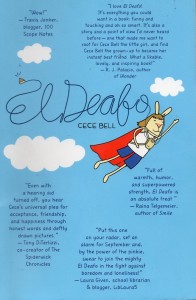Comic Book Review: El Deafo by Cece Bell
Disclaimer: I received this book as a Goodreads giveaway on the premise that I would review it. My copy was an uncorrected proof, and there will be changes in the final product (notably, the proof is in black and white, while the real thing will be in color. Also, the cover will be much less cluttered with endorsements.)
Cece Bell developed profound hearing loss due to an illness when she was four. This children’s graphic novel is a memoir of her life from then until fifth grade. Most of the story is about Cece learning to cope with her hearing loss and the rather obvious hearing aids she was given to mitigate the loss. In particular, her adventures with the “Phonic Ear”, a powerful chest-mounted unit that came with a microphone for her teacher to use.
The title comes about when young Cece realizes that when her teachers don’t take the microphone off, she can hear them speak and what’s going on around them no matter where in the school they are. It’s like a superpower! So Cece imagines herself as the superhero El Deafo.
There is also a theme of learning about friendship. Cece makes several friends over the years, but there are difficulties with each one–sometimes it’s negative qualities of the friend, sometimes it’s Cece’s own self-consciousness and suspicion that causes problems.
The book is written for elementary school children, but has information that will be helpful for parents and other adult relatives, who should immediately turn to the back and read the author’s note. Parents are likely to get many cultural references that might escape children–Cece grew up in a time before television had closed captioning.
There’s some body function humor of the type grade school kids tend to love but many parents are distressed by, and one of Cece’s moments of bonding with her classmates may not sit well with adults who think that disobedience should be forbidden.
For whatever reason, everyone is drawn with “bunny” features, which does allow the hearing aids to be obvious. Cece’s deafness is depicted with empty word balloons, or nonsense words when she can hear some but not clearly enough to understand.
The obvious audience for this book is children with hearing loss and their families, but it will be of interest to any family whose children might encounter someone with hearing loss in their school or activities. And many children will be able to identify with Cece when her “specialness” doesn’t seem positive at all.
Update: In 2015, this book was a Newbery Honor selection, which means that it was a close runner-up for the prestigious Newbery Medal for children’s literature. Congratulations, El Deafo!


Scott, I can see where this would be a valuable book for many, hearing-impaired or non-hearing impaired.
Thanks for stopping by!
this does sound like it is a valuable book – and it makes me realize – as adults we don’t – or I don’t – read graphic novels as often as we should!
It’s easier nowadays that most libraries will stock them. You do have to compete with teens and in this case children, but with interlibrary loan, you can find a good selection.
It’s sounds like it’s a great read for any child – they may not encounter anyone with hearing aids, but they will meet someone who’s different and books like that teach them that it’s ok to be different, and that everyone has their own superpowers. Thank you for sharing this.
Best of all, it’s about a real, fallible person. (Cece depicts herself as having been a brat at times) so kids won’t feel they’re having a plaster saint pushed down their throats.